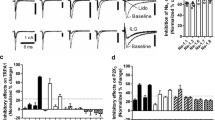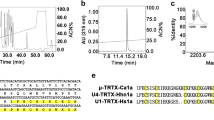Abstract
The neuropeptide nocistatin (NS) is expressed by the nervous system cells and neutrophils as a part of a precursor protein and can undergo stepwise limited proteolysis. Previously, it was shown that rat NS (rNS) is able to activate acid-sensing ion channels (ASICs) and that this effect correlates with the acidic nature of NS. Here, we investigated changes in the properties of rNS in the course of its proteolytic degradation by comparing the effects of the full-size rNS and its two cleavage fragments on the rat isoform 3 ASICs (ASIC3) expressed in X. laevis oocytes and pain perception in mice. The rNS acted as both positive and negative modulator by lowering the steady-state desensitization of ASIC3 at pH 6.8-7.0 and reducing the channel’s response to stimuli at pH 6.0-6.9, respectively. The truncated rNSΔ21 peptide lacking 21 amino acid residues from the N-terminus retained the positive modulatory activity, while the C-terminal pentapeptide (rNSΔ30) acted only as a negative ASIC3 modulator. The effects of the studied peptides were confirmed in animal tests: rNS and rNSΔ21 induced a pain-related behavior, whereas rNSΔ30 showed the analgesic effect. Therefore, we have shown that the mode of rNS action changes during its stepwise degradation, from an algesic molecule through a pain enhancer to a pain reliever (rNSΔ30 pentapeptide), which can be considered as a promising drug candidate.



Similar content being viewed by others
Abbreviations
- ASIC:
-
acid-sensing ion channels
- CNS:
-
central nervous system
- GMQ:
-
2-guanidine-4-methylquinazoline
- NS:
-
nocistatin
- PNS:
-
peripheral nervous system
- rNS:
-
rat nocistatin
- SSD:
-
steady-state desensitization
References
Chu, X.-P., and Xiong, Z.-G. (2012) Physiological and pathological functions of acid-sensing ion channels in the central nervous system, Curr. Drug Targets, 13, 263-271, https://doi.org/10.2174/138945012799201685.
Carattino, M. D., and Montalbetti, N. (2020) Acid-sensing ion channels in sensory signalling, Am. J. Physiol. Renal Physiol., 318, F531-F543, https://doi.org/10.1152/ajprenal.00546.2019.
Wemmie, J. A., Price, M. P., and Welsh, M. J. (2006) Acid-sensing ion channels: advances, questions and therapeutic opportunities, Trends Neurosci., 29, 578-586, https://doi.org/10.1016/j.tins.2006.06.014.
Deval, E., and Lingueglia, E. (2015) Acid-sensing ion channels and nociception in the peripheral and central nervous systems, Neuropharmacology, 94, 49-57, https://doi.org/10.1016/j.neuropharm.2015.02.009.
Schuhmacher, L.-N., and Smith, E. S. J. (2016) Expression of acid-sensing ion channels and selection of reference genes in mouse and naked mole rat, Mol. Brain, 9, 97, https://doi.org/10.1186/s13041-016-0279-2.
Boscardin, E., Alijevic, O., Hummler, E., Frateschi, S., and Kellenberger, S. (2016) The function and regulation of acid-sensing ion channels (ASICs) and the epithelial Na+ channel (ENaC): IUPHAR review 19, Br. J. Pharmacol., 173, 2671-2701, https://doi.org/10.1111/bph.13533.
Osmakov, D. I., Khasanov, T. A., Andreev, Y. A., Lyukmanova, E. N., and Kozlov, S. A. (2020) Animal, herb, and microbial toxins for structural and pharmacological study of acid-sensing ion channels, Front. Pharmacol., 11, 991, https://doi.org/10.3389/fphar.2020.00991.
Salinas, M., Lazdunski, M., and Lingueglia, E. (2009) Structural elements for the generation of sustained currents by the acid pain sensor ASIC3, J. Biol. Chem., 284, 31851-31859, https://doi.org/10.1074/jbc.M109.043984.
Deval, E., Noël, J., Lay, N., Alloui, A., Diochot, S., et al. (2008) ASIC3, a sensor of acidic and primary inflammatory pain, EMBO J., 27, 3047-3055, https://doi.org/10.1038/emboj.2008.213.
Yagi, J., Wenk, H. N., Naves, L. A., and McCleskey, E. W. (2006) Sustained currents through ASIC3 ion channels at the modest pH changes that occur during myocardial ischemia, Circ. Res., 99, 501-519, https://doi.org/10.1161/01.RES.0000238388.79295.4c.
Dulai, J. S., Smith, E. S. J., and Rahman, T. (2021) Acid-sensing ion channel 3: an analgesic target, Channels, 15, 94-127, https://doi.org/10.1080/19336950.2020.1852831.
Gründer, S., and Pusch, M. (2015) Biophysical properties of acid-sensing ion channels (ASICs), Neuropharmacology, 94, 9-18, https://doi.org/10.1016/j.neuropharm.2014.12.016.
Bohlen, C. J., Chesler, A. T., Sharif-Naeini, R., Medzihradszky, K. F., Zhou, S., et al. (2011) A heteromeric Texas coral snake toxin targets acid-sensing ion channels to produce pain, Nature, 479, 410-414, https://doi.org/10.1038/nature10607.
Yu, Y., Chen, Z., Li, W.-G., Cao, H., Feng, E.-G., et al. (2010) A nonproton ligand sensor in the acid-sensing ion channel, Neuron, 68, 61-72, https://doi.org/10.1016/j.neuron.2010.09.001.
Osmakov, D. I., Koshelev, S. G., Andreev, Y. A., Dubinnyi, M. A., Kublitski, V. S., et al. (2018) Proton-independent activation of acid-sensing ion channel 3 by an alkaloid, lindoldhamine, from Laurus nobilis, Br. J. Pharmacol., 175, 924-937, https://doi.org/10.1111/bph.14134.
Alijevic, O., and Kellenberger, S. (2012) Subtype-specific modulation of acid-sensing ion channel (ASIC) function by 2-guanidine-4-methylquinazoline, J. Biol. Chem., 287, 36059-36070, https://doi.org/10.1074/jbc.M112.360487.
Marra, S., Ferru-Clément, R., Breuil, V., Delaunay, A., Christin, M., et al. (2016) Non-acidic activation of pain-related acid-sensing ion channel 3 by lipids, EMBO J., 35, 414-428, https://doi.org/10.15252/embj.201592335.
Osmakov, D. I., Koshelev, S. G., Andreev, Y. A., and Kozlov, S. A. (2017) Endogenous isoquinoline alkaloids agonists of acid-sensing ion channel type 3, Front. Mol. Neurosci., 10, 282, https://doi.org/10.3389/FNMOL.2017.00282.
Osmakov, D. I., Koshelev, S. G., Ivanov, I. A., Andreev, Y. A., and Kozlov, S. A. (2019) Endogenous neuropeptide nocistatin is a direct agonist of acid-sensing ion channels (ASIC1, ASIC2 and ASIC3), Biomolecules, 9, 401, https://doi.org/10.3390/BIOM9090401.
Hallberg, M., and Nyberg, F. (2003) Neuropeptide conversion to bioactive fragments – an important pathway in neuromodulation, Curr. Protein Pept. Sci., 4, 31-44, https://doi.org/10.2174/1389203033380313.
Osmakov, D. I., Koshelev, S. G., Andreev, Y. A., Dyachenko, I. A., Bondarenko, D. A., et al. (2016) Conversed mutagenesis of an inactive peptide to ASIC3 inhibitor for active sites determination, Toxicon, 116, 11-16, https://doi.org/10.1016/j.toxicon.2015.11.019.
Hallberg, M. (2015) Neuropeptides: metabolism to bioactive fragments and the pharmacology of their receptors, Med. Res. Rev., 35, 464-519, https://doi.org/10.1002/med.21323.
Okuda-Ashitaka, E., and Ito, S. (2014) Nocistatin: milestone of one decade of research, Curr. Pharmaceut. Design, 21, 868-884, https://doi.org/10.2174/1381612820666141027112451.
Sakurada, C., Sakurada, S., Orito, T., Tan-No, K., and Sakurada, T. (2002) Degradation of nociceptin (orphanin FQ) by mouse spinal cord synaptic membranes is triggered by endopeptidase-24.11: an in vitro and in vivo study, Biochem. Pharmacol., 64, 1293-1303, https://doi.org/10.1016/S0006-2952(02)01295-9.
Terenius, L., Sandin, J., and Sakurada, T. (2000) Nociceptin/orphanin FQ metabolism and bioactive metabolites, Peptides, 21, 919-922, https://doi.org/10.1016/S0196-9781(00)00228-X.
Montiel, J. L., Cornille, F., Roques, B. P., and Noble, F. (1997) Nociceptin/orphanin FQ metabolism: role of aminopeptidase and endopeptidase 24.15, J. Neurochem., 68, 354-361, https://doi.org/10.1046/j.1471-4159.1997.68010354.x.
Mentlein, R., and Struckhoff, G. (1989) Purification of two dipeptidyl aminopeptidases II from rat brain and their action on proline-containing neuropeptides, J. Neurochemistry., 52, 1284-1293, https://doi.org/10.1111/j.1471-4159.1989.tb01877.x.
Kozlov, S. A., and Grishin, E. V. (2007) The universal algorithm of maturation for secretory and excretory protein precursors, Toxicon, 49, 721-726, https://doi.org/10.1016/j.toxicon.2006.11.007.
Erdös, E. G., and Skidgel, R. A. (1989) Neutral endopeptidase 24.11 (enkephalinase) and related regulators of peptide hormones, FASEB J., 3, 145-151, https://doi.org/10.1096/fasebj.3.2.2521610.
Wu, J., Liu, T. T., Zhou, Y. M., Qiu, C. Y., Ren, P., et al. (2017) Sensitization of ASIC3 by proteinase-activated receptor 2 signaling contributes to acidosis-induced nociception, J. Neuroinflammation, 14, 150, https://doi.org/10.1186/s12974-017-0916-4.
Deval, E., Gasull, X., Noël, J., Salinas, M., Baron, A., et al. (2010) Acid-sensing ion channels (ASICs): pharmacology and implication in pain, Pharmacol. Ther., 128, 549-558, https://doi.org/10.1016/j.pharmthera.2010.08.006.
Gründer, S., Ramírez, A. O., and Jékely, G. (2023) Neuropeptides and degenerin/epithelial Na+ channels: a relationship from mammals to cnidarians, J. Physiol., 601, 1583-1595, https://doi.org/10.1113/JP282309.
Vick, J. S., and Askwith, C. C. (2015) ASICs and neuropeptides, Neuropharmacology, 94, 36-41, https://doi.org/10.1016/j.neuropharm.2014.12.012.
Borg, C. B., Braun, N., Heusser, S. A., Bay, Y., Weis, D., Galleano, I., Lund, C., Tian, W., Haugaard-Kedström, L. M., Bennett, E. P., Lynagh, T., Strømgaard, K., Andersen, J., and Pless, S. A. (2020) Mechanism and site of action of big dynorphin on ASIC1a (supplementary), Proc. Natl. Acad. Sci. USA, 117, 7447-7454, https://doi.org/10.1073/pnas.1919323117.
Kuspiel, S., Wiemuth, D., and Gründer, S. (2021) The neuropeptide nocistatin is not a direct agonist of acid-sensing ion channel 1a (ASIC1a), Biomolecules, 11, 571, https://doi.org/10.3390/biom11040571.
Acknowledgments
We are grateful to Sylvie Diochot (Institut de Pharmacologie Moléculaire et Cellulaire, Valbonne, France) for kindly providing the PCi plasmid coding for rat ASIC3.
Funding
The work was supported by the Russian Science Foundation (project no. 22-75-10021).
Author information
Authors and Affiliations
Contributions
S.A.K., I.A.D., and Y.A.A. conceived and supervised the study; D.I.O., N.V.T., A.A.N., V.A.P., and Y.A.P. carried out the experiments; D.I.O., I.A.D., Y.A.A., and S.A.K. discussed the results of experiments with the input from all authors; D.I.O. and S.A.K. wrote the manuscript; A.A.N. and Y.A.A. edited the manuscript.
Corresponding author
Ethics declarations
The authors declare no conflicts of interest. All experimental procedures in this study were conducted according to the international and institutional guidelines.
Additional information
Publisher’s Note. Pleiades Publishing remains neutral with regard to jurisdictional claims in published maps and institutional affiliations.
Rights and permissions
About this article
Cite this article
Osmakov, D.I., Tarasova, N.V., Nedorubov, A.A. et al. Nocistatin and Products of Its Proteolysis Are Dual Modulators of Type 3 Acid-Sensing Ion Channels (ASIC3) with Algesic and Analgesic Properties. Biochemistry Moscow 88, 2137–2145 (2023). https://doi.org/10.1134/S0006297923120155
Received:
Revised:
Accepted:
Published:
Issue Date:
DOI: https://doi.org/10.1134/S0006297923120155




